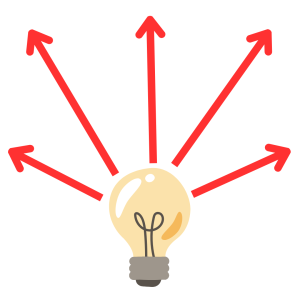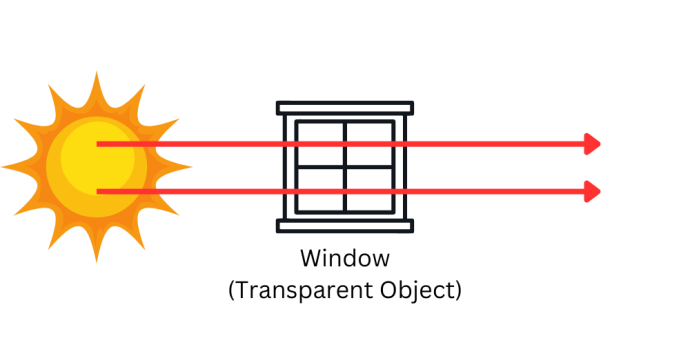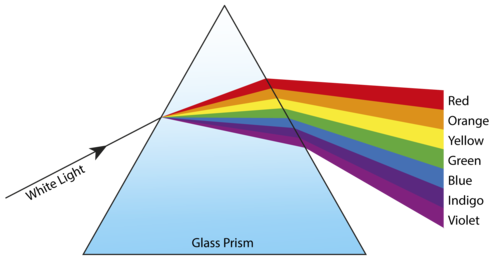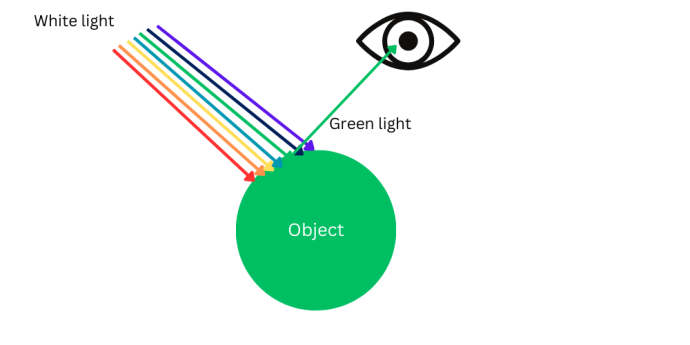When we talk about light we usually mean the light we can see with our eyes.
This is also called visible or optical light.
Light is one way energy can be transferred - moved from one place to another.
Most of the light we have on Earth comes from the Sun.
The energy it brings means that life can survive on Earth.

- Luminous and Non-Luminous Objects
There are other sources of light on Earth, like fire and lightbulbs. Lightbulbs use electricity or solar power, and we see some of the emitted energy as visible light.
Objects that create their own light are known as luminous objects.
Other objects do not create their own light but reflect the light landing on them, like a book or clothing. The Moon reflects light from the Sun.
We call these non-luminous objects.
- How does light travel?
- Image
 CreditThis work by The Schools' Observatory is licensed under All rights reserved
CreditThis work by The Schools' Observatory is licensed under All rights reservedA ray diagram showing light (represented by the red arrows) emitted from a bulb For us to see, light must travel from a light source to our eye. The light we see on Earth travels in straight lines.
A ray diagram shows the path light takes as it travels.
It includes what happens when it reaches a surface, such as a lens, mirror or other object.
Light is represented with straight lines, and the arrows point in the direction the light travels.
Image CreditThis work by The Schools' Observatory is licensed under All rights reserved
CreditThis work by The Schools' Observatory is licensed under All rights reservedLight (represented by the red arrows) passing through a transparent object. Anything in the path of light has an effect on what we see.
For example, a window is transparent – this means that the light can pass straight through it.
An opaque object, like a ball, will block the light travelling towards it. This is what creates a shadow.
Image CreditThis work by The Schools' Observatory is licensed under All rights reserved
CreditThis work by The Schools' Observatory is licensed under All rights reservedLight (represented by the red arrows) is blocked by an opaque object. Only light not in the objects path can travel past it. This creates an area with no light, which is the objects shadow. Image CreditThis work by The Schools' Observatory is licensed under All rights reserved
CreditThis work by The Schools' Observatory is licensed under All rights reservedLight (represented by the red arrows) reflecting off the surface of the book to reach our eyes. Some of the blocked light is absorbed by the object, making it hotter, and the rest of the light is reflected.
This is how we see things.
Light hits the surface of an object and bounces off the surface, sending the light to our eyes.
Some objects reflect more light than others. We can change the direction of light by placing a very reflective object, like a mirror, in its path. This is how most telescopes work.
- Colours of Light
The light we see looks white, but it is made up of every colour of the rainbow.
You can split white light into all of its colours by placing a glass prism in its path. We see this effect when the Sun shines through rain in the air to make a rainbow.
Image CreditThis work by Jibin 1840404 is licensed under Creative Commons Attribution Share Alike 4.0 InternationalImage
CreditThis work by Jibin 1840404 is licensed under Creative Commons Attribution Share Alike 4.0 InternationalImage CreditThis work by SharkD is licensed under Creative Commons Zero v1.0 Universal
CreditThis work by SharkD is licensed under Creative Commons Zero v1.0 UniversalHow the primary colours of light combine The 3 primary colours are red, green and blue.
Our eyes have special cones inside of them that detect colours. We have 3 types of cones - one for each of the primary colours.
When more than one colour is detected, they combine together.
These different mixtures create all the other colours we can see.
An object's colour is the result of the light which is reflected. White objects reflect all colours of light landing on them, perfectly black objects reflect no light.
Image CreditThis work by The Schools' Observatory is licensed under All rights reserved
CreditThis work by The Schools' Observatory is licensed under All rights reservedWhite light (made of all the colours of the rainbow) hitting a white surface and a black surface If an object looks green it’s because it is reflecting the green light landing on it, but absorbing the other colours.
Image CreditThis work by The Schools' Observatory is licensed under All rights reserved
CreditThis work by The Schools' Observatory is licensed under All rights reservedLight is actually much more complicated this. As well as the light we can see with our eyes there are lots of other types of light. The full range of light is called the electromagnetic spectrum.
